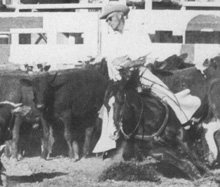Roy Huffaker, 80, who died last Friday, March 14, won the 1969 National Cutting Horse Association World Championship on Jose Uno, a bald-face Joe’s Last son bred by John Kenney, and owned in his early years by James Kenney. James Kenney won the 1968 NCHA Futurity on the Jose Uno daughter Uno Princess, the first Futurity winner sired by a world champion.
 Kenney (pictured on Jose Uno), who passed in 2006 at 91, grew up on his grandparents’ farm south of Midland, Texas. His father, a respected cowboy, had been ambushed and killed by cattle rustlers, when Kenney was seven. At 14, James left home on horseback to fulfill his dream of becoming a cowboy like his father.
Kenney (pictured on Jose Uno), who passed in 2006 at 91, grew up on his grandparents’ farm south of Midland, Texas. His father, a respected cowboy, had been ambushed and killed by cattle rustlers, when Kenney was seven. At 14, James left home on horseback to fulfill his dream of becoming a cowboy like his father.
“I’m going to quit school,” he told his mother. “I don’t think I need to go anymore. I want to be a cowboy, and I can’t learn to be a cowboy up there in that school house.’”
A keen observer and poet at heart, Kenney became a top hand. Later in life, as a successful rancher and horse breeder, he liked to recount his adventures as a boy, working for some of the last great outfits and the last men of the open range.
Here, in his words, is one among many stories that he shared with me:
Foy (Proctor) came up there one day and told Big Boy about a big gray horse down south of Midland that had been bucking the boys off. They called this horse Cherry Pie. He was a big stout, good-looking horse.
“If you don’t mind, Big Boy,” Foy said, “I might buy that horse and send him up here and let you ride him.” Big Boy could really ride broncs.
“You just buy him and send him up here,” Big Boy said.
Claude Armstrong and his cowboys and wagon were coming up there pretty quick. I had a grulla paint horse that I broke the first year I stayed there. He sure made a good horse. I had my saddle on him and had him tied up to the fence. When I looked up and saw the remuda coming, I knew this wagon was right behind them.
It was on a Sunday and Big Boy had been making a little home brew and drinking it pretty good. It was about noon by the time the wagon got there and when they did, Big Boy asked me if he could borrow my horse. He went out and cinched him up real good and took my rope down and put it on the saddle horn. Then he asked Claude Armstrong, “Which one of them horses is Cherry Pie?”
“There he is, right there,” Claude said. “That gray horse.”
Before we knew it, Big Boy had roped this sonofagun and pulled the loop up right around his throat latch. That old horse snorted and pawed at his head and went right to the end of the rope, but this grulla paint pony was stout and he held him pretty good.
Big Boy stepped off my grulla pony and went down and grabbed that gray horse by the mane. He was flouncing and jumping at the end of the rope and would nearly throw Big Boy. But Big Boy would hang his spur in his flank and stay on him.
This horse just finally humped up and stopped, and Big Boy leaned over and said, “Cherry Pie, this here is Big Boy. I want you to pay attention to me. Me and you is going to get along real good.” That was the end of Cherry Pie. He wasn’t near as rank as everybody thought he was.
Big Boy could ride those silly old horses and scare them nearly to death. He knew that you have to start on them and don’t let them start on you. He’d do something unusual to one of them and he’d say, “I want you to look at me. This here is Big Boy.”
Big Boy was a little feller and he went by three names – Big Boy, Henry Brady and Little Boy. He had one leg a little shorter than the other one and he walked with a limp, real quick. He sure was a good hand and I got a good education helping him break horses. A lot of grown men didn’t know what I knew by the time I was fifteen. But I was lucky enough to get started with somebody like Big Boy, who knew how to do everything.”
